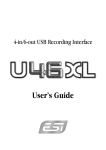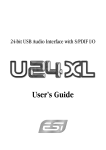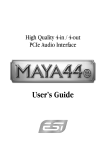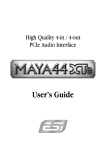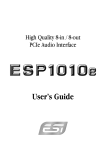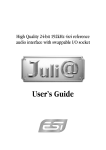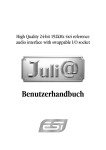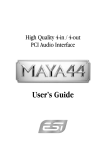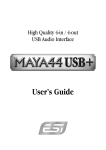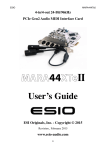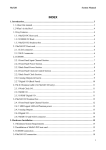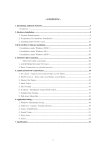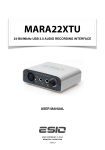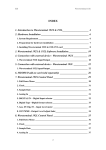Download ESI DuaFire User`s guide
Transcript
2-in/4-out FireWire Recording Interface User’s Guide ESI - Copyright © 2007 Revision 1, November 2007 www.esi-audio.com DuaFire ESI INDEX 1. Introduction.................................................................................................................................. 4 1.1 Key Features ........................................................................................................................................................ 4 2. Description of DuaFire ................................................................................................................ 5 2.1 Front Panel........................................................................................................................................................... 5 2.2 Rear Panel ............................................................................................................................................................ 5 2.3 Minimum System Requirements.......................................................................................................................... 6 3. Installation .................................................................................................................................... 7 3.1 Windows XP ........................................................................................................................................................ 7 3.2 Windows Vista..................................................................................................................................................... 9 3.3 Mac OS X .......................................................................................................................................................... 10 4. DuaFire Control Panel .............................................................................................................. 11 4.1 Input Monitor controls ....................................................................................................................................... 11 4.2 Output controls................................................................................................................................................... 12 4.3 Master controls................................................................................................................................................... 12 4.4 Config controls................................................................................................................................................... 13 4.5 DirectWIRE ....................................................................................................................................................... 13 5. Audio Applications..................................................................................................................... 16 5.1 Windows Multimedia setup ............................................................................................................................... 16 5.2 Latency setting and ASIO applications under Windows.................................................................................... 16 5.3 Mac OS X Audio MIDI Setup ........................................................................................................................... 16 5.4 Cubase LE 4....................................................................................................................................................... 17 6. General Information .................................................................................................................. 19 3 DuaFire ESI 1. Introduction Thank you for choosing the ESI DuaFire. DuaFire is an ideal mobile recording interface for both laptops and desktop computers. It offers 2 input and 4 output channels. DuaFire is also the world’s first FireWire audio interface that perfectly supports the EWDM technology from ESI. ESI has finally adopted the famous EWDM technology to a FireWire Audio interface. Now you can use driver interfaces like ASIO 2.0, GSIF 2.0, MME and WDM simultaneously with the same features that made ESI's PCI audio interfaces famous. Of course, EWDM for FireWire also provides the DirectWIRE technology the virtual digital patchbay and support for very low latency values (as low as 1.5ms or even less). This ensures best compatibility with all major audio applications. To get started right away, the full featured Cubase LE 4 recording software from Steinberg is bundled. The flexible inputs allow you to record from a variety of different sources. You can directly connect devices with line level, turntables via the built-in phono preamp, microphones (+48V phantom power support) and Hi-Z signals (e.g. a guitar). 1.1 Key Features - 2-in 4-out multi purpose FireWire audio interface - 2 line level inputs, switchable to 2 phono level inputs (mono) - microphone input with gain control - +48V phantom power for condenser microphone - direct instrument input for electric guitars (Hi-Z) with gain control - 4 line level analog outputs - headphone out with level control - bus powered, i.e. can be used without external power supply (*) - 2 channel recording and 4 channel playback at the same time – Full Duplex - WDM, MME, ASIO 2.0, GSIF 2.0, CoreAudio and DirectSound support - bundled with Cubase LE 4 DVD-ROM - compatible with Windows and Mac OS X *) this is only possible with a 6-pin to 6-pin FireWire connection and a FireWire port that provides enough voltage for DuaFire. Devices with 4-pin FireWire port do not provide any voltage for bus powered operation. 4 DuaFire ESI 2. Description of DuaFire 2.1 Front Panel The front panel has the following connectors and controls from left to right: Input 1: the first input channel is provided as balanced XLR input (MIC IN) for microphones and 1/4"-input (LINE IN) for line level signals. You can only use one of the two input connectors at a time. The input level is controlled by the GAIN knob with peak LED next to it. Above the gain knob is the +48V phantom power switch with LED that needs to be enabled if you are using a condenser microphone. For a dynamic microphone, phantom power does not have to be enabled. Input 2: the second input channel is provided with a 1/4" connector (LINE / HI-Z IN) that can be used for line level signals or high impedance instrument signals (like a guitar). Next to it is the GAIN knob to control the input level. With the HI-Z switch, you can switch between line level and instrument / guitar signals. Headphone Out: the HEADPHONE output with 1/4" connector and gain control is located on the right side (directly under the POWER LED). 2.2 Rear Panel The rear panel has the following connectors and controls from left to right: Power Connector: even though DuaFire is bus-powered, it might be needed to connect an external power supply (e.g. when DuaFire is connected to a PC with a 4-pin FireWire port). The power supply gets connected to the DC IN port. FireWire port: the FIREWIRE connector is used to connect DuaFire to the computer. 5 DuaFire ESI Power Switch: the power switch has three positions. If the switch is in the middle position (OFF), DuaFire is turned off. If the switch is set to BUS., DuaFire will take its power from the computer (bus powered operation). This requires a 6-pin to 6-pin FireWire cable. If the switch is set to EXT., DuaFire gets powered by an external power supply connected to the DC IN port. Output 1 / 2: the first output pair is provided with 1/4" TRS connectors. Use these line outputs to connect DuaFire to your mixing desk, monitoring speakers or other studio equipment. Output 3 / 4: the second output pair is provided with RCA connectors. Use these unbalanced line outputs to connect DuaFire to other studio or HiFi equipment. Line / Phono Switch: the LINE / PHONO switch allows you to switch between line level and phono level inputs. Inputs 1 / 2: In addition to the XLR and 1/4" connectors on the front panel, DuaFire also provides RCA inputs for phono signals on the back panel. Please note that these inputs cannot be used simultaneously as the inputs on the front panel. To use the phono inputs, the LINE / PHONO switch must be set to phono. Ground Connector: if you are using the phono inputs and have them directly connected to a turn table, please connect this ground connector to ground to avoid humming. 2.3 Minimum System Requirements PC - Intel Pentium III 600MHz CPU or equivalent AMD CPU one available FireWire 400 port at least 512 MB RAM at least 1 GB available space on HDD DVD-ROM drive (for Cubase LE 4 installation) internet connection (for Cubase LE 4 activation) Windows XP (with Service Pack 2) 32-bit or Windows Vista 32-bit Mac - 6 Power Macintosh G4 or higher one available FireWire 400 port at least 512 MB RAM at least 1 GB available space on HDD DVD-ROM drive (for Cubase LE 4 installation) internet connection (for Cubase LE 4 activation) Mac OS X 10.3 or higher DuaFire ESI 3. Installation Before installing the drivers of DuaFire, we recommend to check on the download section of www.esi-audio.com for updated drivers. 3.1 Windows XP Switch off DuaFire via the power switch on the rear panel before you install the driver (put the switch in the middle position). Then launch setup.exe from the Windows XP folder of the included driver CD or from a download of a recent driver from our website. Make sure the driver you are about to install is intended for Windows XP. You will now see a dialog as shown on the left picture below. Click Next. You can define the target directory for the installation now. Confirm it with Next. The installer now informs you that the driver installation will start as shown on the left picture below. Confirm this with Next. During the following process you will see a dialog box once or several times that informs you that the driver software has not passed Windows Logo testing. Please be assured that our drivers have been tested in various different ways and are OK to be used. Confirm any such dialog with Continue Anyway. 7 DuaFire ESI You will now be prompted to switch on the hardware on the next dialog that is shown below on the left. Plug in DuaFire and switch on the unit with the power switch. Do not click Next yet. The Found New Hardware Wizard will appear after DuaFire gets detected (as shown on the right). Keep the selection on Install the software automatically (Recommended) and click Next. Windows will again prompt you to confirm the Windows Logo testing dialog with Continue Anway before the driver installation is finalized. Confirm it with Finish (as shown on the following two pictures). You can now finally click Next on the ESI DuaFire Audio Driver Setup dialog. The installation is now finished. To confirm this, please check if the ESI icon is displayed in the taskbar notification area as shown below. If yes, the driver installation has been completed successfully. 8 DuaFire ESI 3.2 Windows Vista Switch off DuaFire via the power switch on the rear panel before you install the driver (put the switch in the middle position). Then launch setup.exe from the Windows Vista folder of the included driver CD or from a download of a recent driver from our website. Make sure the driver you are about to install is intended for Windows Vista. When launching the installation, Windows Vista might prompt a security message. Make sure to allow the installation. You will then see a dialog as shown on the left picture below. Click Next. You can define the target directory for the installation now. Confirm it with Next. The installer now informs you that the driver installation will start as shown on the left picture below. Confirm this with Next. During the following process you will see a Windows Security dialog box once or several times that asks you for confirmation to install the driver software. Confirm any such dialog with Install. You will now be prompted to switch on the hardware on the next dialog that is shown below on the left. Plug in DuaFire and switch on the unit with the power switch. Do not click Next yet. Instead, wait a few seconds for the automatic device driver installation. You can monitor this in the task notification area where Windows Vista informs that the driver is installed via a bubble message box. Once finished, click on the message box to get the confirmation shown on the right below. 9 DuaFire ESI You can now finally click Next on the ESI DuaFire Audio Driver Setup dialog. The installation is now finished. To confirm this, please check if the ESI icon is displayed in the taskbar notification area as shown below. If yes, the driver installation has been completed successfully. 3.3 Mac OS X Mac OS X already provides support for class compliant FireWire audio devices such as DuaFire. This means that no software or driver needs to be installed to use DuaFire under Mac OS X. Simply connect the unit with the supplied FireWire cable to your Mac, make sure it is switched on and you can start using it. Controlling the basic options of DuaFire under Mac OS X is mainly done via the Audio-MIDI-Setup utility from Mac OS X described in section 5.3 of this manual. 10 DuaFire ESI 4. DuaFire Control Panel This chapter describes the DuaFire Control Panel under Windows. Under Mac OS X no special Control Panel is required for DuaFire. If you are using DuaFire under Mac OS X, please check section 5.3 with more details. To open the control panel double click on the ESI icon in the task notification area. The following dialog will appear: This control panel is divided into an Input Monitor, Output and Master section. In addition, current status information (Sample Rate and Latency) is displayed on the right and further controls are available via the pull down menu. 4.1 Input Monitor controls The Input Monitor section allows you to control the volume of the input monitoring signal. When you are monitoring an input signal, it means that you listen to it via the outputs. All the monitoring features of DuaFire provided in this Control Panel are controlling the actual hardware, i.e. there is no delay / latency involved – everything is routed and processed in realtime. There are two faders, one of each controls the monitoring volume for input channel 1, while the second one controls the monitoring volume for input channel 2. Each channel has a MUTE button that allows you to temporarily mute that input signal. A red MUTE button indicates that the mute function is enabled. When disabled, the button is gray. Under these two buttons is a round button that is used to link the two channels. When enabled (purple color), the two faders are controlled simultaneously. This is perfect if you are controlling a stereo input signal (i.e. from a turn table connected to the PHONO inputs on the back). When disabled (gray color), the two faders are totally independent, which is useful when you have two 11 DuaFire ESI different mono input sources, like a microphone on MIC IN (input 1) and a guitar on HI-Z IN (input 2). The two buttons, labeled INPUT 1 and INPUT 2 on top of the Input Monitor section, allow you to enable (purple color) and disable (gray color) the monitoring and at the same time allow you to generate a mono down mix of each input signal in case you want to monitor a single mono source on both speakers. There are 4 different settings for the two buttons: When both buttons are disabled, no input signals are monitored. When INPUT 1 is enabled alone, the signal is monitored on both the left and right channel together. When INPUT 2 is enabled alone, the signal is monitored on both the left and right channel together. When both buttons are enabled, each input signal is monitored on each channel – i.e. input 1 is audible on the left channel only and input 2 is audible on the right only. A mono down mix (for example when INPUT 1 is enabled but INPUT 2 is disabled) is useful when you have a mono source like a microphone but want to listen to it in stereo while recording (i.e. if you monitor your signals with headphones or if you have no mixing desk). 4.2 Output controls The Output section controls the playback volume of each playback signal from your audio applications. There are four individual faders for each playback channel, divided into the Output 1/2 and Output 3/4 sections. Each pair of mono faders can be linked together with the round button under each section. When enabled (purple color), the two faders are controlled simultaneously – perfect for stereo signals. When disabled (gray color), the two faders are controlled independently. The MUTE button under each channel allows you to mute playback for the specific channel. A red MUTE button indicates that the mute function is enabled. When disabled, the button is gray. 4.3 Master controls The Master section is controlled to control the master output volume of DuaFire, i.e. it controls the mix of the playback from your application and the input signals (if input monitoring is enabled). The pair of mono faders can be linked together with the round button at the bottom. When enabled (purple color), the two faders are controlled simultaneously – recommended and perfect for stereo signals. When disabled (gray color), the two faders are controlled independently. The MUTE button under each channel allows you to mute playback for the specific channel. A red MUTE button indicates that the mute function is enabled. When disabled, the button is gray. 12 DuaFire ESI 4.4 Config controls The Config menu contains additional important controls for DuaFire: Mouse Wheel The faders of the DuaFire Control Panel can be changed with the mouse wheel when you move your mouse over each fader. This menu option allows you to define how many steps each mouse wheel step generates in fader movement. Latency With the Latency menu entry, you can change the latency of the ASIO and GSIF driver of DuaFire in ms. Depending on the typical application (e.g. for playback of software synthesizers) a smaller latency is an advantage. At the same time, the best latency setting indirectly depends on the performance of your system. For recording applications, a typical latency buffer size between 4 and 8ms is standard. Note that the latency has to be setup before launching any audio application. Factory Default Use this menu entry to reset all Control Panel settings to the recommended default values. Always on Top When this option is enabled, the DuaFire panel will appear visible on screen even if another application has the focus. Clone 2-way from Out 1,2 When this option is enabled, playback from channel 1/2 is ‘cloned’ to output channel 3/4. This is a great feature, for example when you want to use the 1/4" and the RCA outputs simultaneously with the same signal. However, for multi channel playback applications, this option should be disabled, so only enable it when you really need it. SampleRate This menu entry allows you to change the current operating sample rate of DuaFire. 4.5 DirectWIRE What is DirectWIRE? DirectWIRE is a driver technology, developed by ESI, which can be used for routing audio streams internally within applications using EWDM Audio MIDI Drivers exclusively developed by ESI. With the DirectWIRE router, an application can record from other application’s audio outputs without external wiring or any loss of data when they are running at the same time. This works within applications using standard audio drivers such as WDM, ASIO and MME. DirectWIRE also allows you to easily rip any audio stream in real time by transferring data thru DirectWIRE from MP3s, live On-line Broadcast and On-demand content, and more. 13 DuaFire ESI DirectWIRE Panel Click on DirectWIRE on the DuaFire control panel. The DirectWIRE panel window as shown below will appear. The number on the row represents the input or output port. The columns represent ins and outs (on and off) of the respected drivers. Patch the virtual cables from one point to another as you drag your mouse point. INPUT section: It's used to route signals from the card's hardware inputs. MME section represents general application's I/O: Ex.) WinAmp, WaveLab (non ASIO mode), Cakewalk, Audition, Vegas, etc. WDM section represents Multi-MME application’s I/O: Ex.) SONAR (when using WDM/KS), PowerDVD, WinDVD, etc. ASIO section represents ASIO application’s I/O: Ex.) Cubase, Logic, Reason, Nuendo, SONAR (when using ASIO), Samplitude, etc. GSIF section represents GSIF application like GigaStudio. Note that some applications support multiple driver modes. DirectWIRE Examples EX1. Recording from WinAmp (MME) to WaveLab (MME) Caution: If you want to record what's played back in WinAmp, but don't want to hear the sound, you should click the OUT button in the MME section so it'll change to OFF. 14 DuaFire ESI EX2. Recording from WinAmp (MME) to SONAR (WDM) EX3. Recording from WinAmp (MME) to Cubase, Logic, Nuendo (ASIO) EX4. Recording from GigaStudio (GSIF) to SONAR (WDM) EX5. Recording from GigaStudio (GSIF) to Cubase (ASIO) 15 DuaFire ESI 5. Audio Applications This chapter contains basic configuration examples for some popular software applications. Please also refer to the manual of the audio software you use for detailed information. 5.1 Windows Multimedia setup The Windows Multimedia setup is required if you want to use your DuaFire as the main sound device for Windows multimedia applications. Go to My Computer-> Control Panel -> Sounds and Audio Device Properties -> Audio. Select the DuaFire entry as your playback device to make sure that all standard signals are played via the DuaFire hardware. 5.2 Latency setting and ASIO applications under Windows Via Config > Latency in the Control Panel it is possible to change the latency setting (also called “buffer size”) for the ASIO driver of DuaFire. A smaller latency is the result of a smaller buffer size. Depending on the typical application (e.g. for playback of software synthesizers) a smaller latency is an advantage. At the same time, the best latency setting indirectly depends on the performance of your system. For recording applications, a typical latency buffer size between 4 and 8ms is standard. Note that the latency has to be setup before launching the ASIO application using DuaFire. 5.3 Mac OS X Audio MIDI Setup The main control center of DuaFire under Mac OS X is the Audio MIDI Setup application that you can find in your Applications folder. When you launch it, you can setup DuaFire as your Default Input, Default Output or System Output device – if required. While audio production and editing applications usually provide an option inside their preferences to select DuaFire as recording and playback device, many general standard applications such as iTunes for example are usually accessing the Default Output device, selectable in the Audio MIDI Setup dialog. 16 DuaFire ESI If you want to change settings of DuaFire, you need to select it under Properties For as shown in the picture above. You can change the default sample rate under Audio Input -> Format or Audio Output -> Format or you can change the main playback volume under Audio Output -> Volume Slider -> M. Default Output Sometimes it might be required to playback signals by default not through the master output 1/2 but through output 3/4. Imagine for example, you want to have iTunes play signals via the RCA outputs of DuaFire connected to your HiFi system while the master 1/4"output is still connected to your mixing desk. To achieve this, we must route the default playback to output 3/4 rather than 1/2. This is where the Configure Speakers button should be utilized. Under the Stereo tab, you can individually select each one of the 4 physical mono output channels of DuaFire for the left front speaker and the right front speaker signal. To route signals as required for our example to output 3/4, you would select 0 3 for left front and 0 4 for right front. The second number in this list equals the physical output channel of the hardware. When you are ready, confirm the change with Done. Note that such a setup is not required for multi channel applications, i.e. Cubase LE 4. Only the output routing for applications that are only supporting stereo should be adjusted by this. 5.4 Cubase LE 4 DuaFire ships with a DVD-ROM with Cubase LE 4 from Steinberg. If you are using a different recording software, you can skip this section. Installation To install Cubase LE 4, insert the DVD-ROM into the DVD-ROM drive of your computer. Under Windows, the installation will normally start automatically – if not, you can launch it manually by starting the installer from the DVD-ROM drive. To install Cubase LE 4 under Mac OS X, double click on the installer icon. To proceed with the installation, follow all instructions on screen. During the installation the Syncrosoft License Control software will be installed as well. To use Cubase LE 4 for more than 30 days, you need to activate it with this software via the internet. This means that you need an active internet connection on the computer you are installing Cubase LE 4. We recommend you to activate the software as early as possible. Initial Setup As most digital audio applications, Cubase LE 4 requires some initial configuration, before it can be used properly with a new audio interface like DuaFire. Start Cubase LE 4 and select Device Setup from the Devices menu. In the dialog (the Mac OS X Version is displayed below, under Windows 17 DuaFire ESI the look is slightly different but the functions are identical), select VST Audio System on the tree structure on the left part of the window. Make sure to select ESI DuaFire ASIO as ASIO Driver entry. You can verify your selection by selecting the ESI DuaFire device on the left. The dialog (as shown above on the right), now lists all input and output channels. Note that the Control Panel button has no effect. Confirm your changes by clicking OK. Now its time to select the input and output channels. From the Devices menu, select VST Connection. The VST Connections window appears. Select the Inputs tab: For every input channel you are intending to use simultaneously, you need to create a separate bus. Cubase LE 4 allows you add mono or stereo busses – what is better for your application depends on the situation. For example, if you record from a microphone, you typically would use a mono bus. If you record from a CD Player with a stereo line output, you would use a stereo bus instead as the signal you are recording is already stereo. With Add Bus you can add a new Mono or Stereo bus. The screen shot above shows one single stereo bus which allows you record from both input channels of DuaFire to one stereo track. In the Device Port column, you can assign a physical hardware input of DuaFire to each bus. Select the Outputs tab to configure the output busses: 18 DuaFire ESI As with inputs, your output busses can also be mono or stereo. The example above lists two stereo output busses, of which the first one would typically be used as your master output. Under Device Port you can assign the physical hardware output channel to each bus. You can now start using Cubase LE 4 by opening an existing project or creating a new project. The input and output busses you have created can be assigned to the individual tracks of your project. 6. General Information Trademarks ESI and DuaFire are trademarks of Ego Systems Inc. and ESI Audiotechnik GmbH. Windows is a trademark of Microsoft Corporation. Other product and brand names are trademarks or registered trademarks of their respective companies. The FCC and CE Regulation Warning This device complies with Part 15 of the FCC Rules. Operation is subject to the following two conditions: (1) this device may not cause harmful interference, and (2) this device must accept any interference received, including interference that may cause undesired operation. Caution : Any changes or modifications in construction of this device with are not expressly approved by the party responsible for compliance, could void the user's authority to operate equipment. Note: This equipment has been tested and found to comply with the limits for a Class A digital device, pursuant to Part 15 of the FCC Rules. These limits are designed to provide reasonable protection against harmful interference when the equipment is operated in a commercial environment. This equipment generates, uses, and can radiate radio frequency energy and, if not installed and used in accordance with the instruction manual, may cause harmful interference to radio communications. Operation of this equipment in a residential area is likely to cause harmful interference in which case the user will be required to correct the interference at his own expense. If necessary, consult an experienced radio/television technician for additional suggestions. Correspondence For technical support inquiries, contact ESI support online at www.esi-audio.com. 19 DuaFire ESI Disclaimer All features and specifications subject to change without notice. Parts of this manual are continually being updated. Please check our web site www.esi-audio.com occasionally for the most recent update information. 20




















